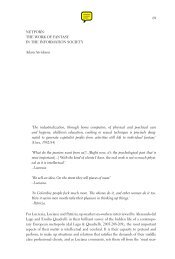Nakamura, Digitizing Race, Introduction, chapter 5, Epilogue
Nakamura, Digitizing Race, Introduction, chapter 5, Epilogue
Nakamura, Digitizing Race, Introduction, chapter 5, Epilogue
You also want an ePaper? Increase the reach of your titles
YUMPU automatically turns print PDFs into web optimized ePapers that Google loves.
142 Avatars and the Visual Culture of Reproduction<br />
position, and because of the visual styles that they prefer. While Ryan and<br />
the Pfeiffers are quite clear about not having invented modernism, but<br />
rather having applied it to an area of the home where it had not been seen<br />
before so as to make a whole house internally consistent in terms of its<br />
style, Ryan also notes that his crib design was a “hack” or modification of an<br />
existing crib, which he found inelegant and bulky. The user-driven innovation<br />
that comes from modifying existing doll bodies is envisioned as either<br />
“creepy” and socially marginal or trivial partly because it deals with babybodies<br />
themselves, rather than furniture or more general types of design<br />
objects. However, these types of modifications or hacks give voice and vision<br />
to the culture of “frilly femininity” overtly critiqued by nursery modernists.<br />
The gendering of pregnancy and baby material culture turns on the axis of<br />
two types of taste cultures that can be classified as female and male, lower<br />
and upper, modifier/consumer and creator/designer. Recent articles in the<br />
popular press regarding “sophisticated babies” and “the modernist nursery”<br />
note that “good design” has dared to invade the one domestic space that<br />
had been exempted from this injunction to adhere to standards defined by<br />
taste cultures: the nursery. While “decoration” has long been dismissed as<br />
feminine, “design” is perceived as more substantial, more the province of<br />
experts, and more connected to architecture, a “masculine” field that has<br />
immense social prestige.<br />
The notion of a taste culture as something that can be created, rather<br />
than merely consumed, by its own users, who are consequently freed from<br />
the necessity of engaging with “tacky commercialism,” has long been a part<br />
of the discourse of the Internet and its potential for interactivity. The Internet’s<br />
stance toward commercialism has for the most part been a critical and<br />
oppositional one, with its more utopian critics envisioning the Internet as a<br />
form that allows “the people” to create commonly owned and collaboratively<br />
created software as in the case of the open-source and creative commons<br />
movements, and fan-authored media and taste cultures. There has, however,<br />
been little writing on taste, class, and gender when it comes to Internet visual<br />
culture. The injunction of the crib designer Michael Ryan to “tone it down,<br />
man,” maps quite well onto the design imperatives and values of new media<br />
professionals, who favor sites that are “simple, elegant, low profile, [with] no<br />
embellishments,” while “fluffiness out there, mixing textures, frilling,” is<br />
despised in both baby carriages and digital design. 22<br />
Women’s digital signatures on pregnancy sites function figuratively as the<br />
“nursery” in the habitus of cyberspace, indulging in a type of frilly femininity<br />
on the level of taste and design that is deeply threatening and subversive





